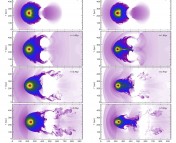Title: Stellar archeology: a cosmological view of dwarf galaxies
Author: Stefania Salvadori
Author’s Institution: Kapteyn Astronomical Institute, Groningen, The Netherlands
Our Milky Way Galaxy is not as lonely as one would think. In fact it is part of a neighborhood of galaxies known as the Local Group. Included in this group are the Andromeda Galaxy and a handful of satellites: smaller galaxies that gravitationally cling to the sides of Andromeda and the Milky Way like cosmic barnacles. They’re known as dwarf galaxies and their origins are not entirely understood yet. Dwarf galaxies generally consist of older stars. They contain very little gas or dust and as a result have very low star formation rates. Many dwarf galaxies are elliptical or spheroidal in shape, which suggests that they are possibly the remnants of a galactic collision.
Because dwarf galaxies are populated by very old stars, they provide astronomers with a cosmological archeology site of sorts. The ancient galaxies can be used to study the conditions under which stars were forming in the early universe. Stefania Salvadori of the Kapteyn Astronomical Institute in The Netherlands set out to examine the formation of the Milky Way and its satellite dwarf spheroidal galaxies (dSph).
When the universe was young and the first stars began to form, they had very low metallicities (the ratio of heavier elements to hydrogen and helium) because there were few previous stars to enhance the fraction of heavy elements in the Universe via nuclear fusion. Nuclear fusion and supernovae explosions are the mechanisms by which heavy elements are produced. Supernovae occur and plant the seed for the next generation of stars, which will contain a greater proportion of heavier elements than the generation before them. For this reason, low-metallicity stars provide a window into the early universe. As Salvadori put it: “. . . living metal-poor stars represent the fossil records of the early cosmic star formation. Indeed they are expected to form at high redshifts, as soon as the metal (and dust) content of the gas was high enough . . . to trigger the formation of low-mass stars, which can survive until the present day.”

Figure 1: Iron abundance vs luminosity of ultra-faint (UF) and classical dwarf spheroidal galaxies. The UF regions of a dSph are regions of ineffective hydrogen-cooling that have relatively low star formation rates.
The author set out to produce a model for dSph formation that is consistent with observations. Her model shows that a dwarf spheroidal galaxy has a very intimate relationship with its host galaxy. The (relatively low) star formation rate within the dSph is greatly influenced by enrichment of heavy elements via supernova explosions in the host. Figure 1 demonstrates the relationship between iron abundance ([Fe/H] represents the logarithm of the iron-to-hydrogen ratio, relative to that of the Sun) and luminosity. The larger the iron abundance, the greater the star formation rates, and the higher the luminosity. The colored points represent the results of the model (several simulation runs) and the black points are observational data. The model Salvadori has constructed seems to agree with observation fairly well. An accurate model will allow astronomers to probe these dwarf galaxies further in an attempt to better understand their origins and the environmental conditions of the early universe.



